"Why don't we go in and recharge?" "This rule discriminates against us when we plug in trams!" Recently, a number of car owners living in Shenzhen and Huizhou complained to understand notes, saying that some electric vehicle fast charging stations refused to charge their plug-in hybrids. Some unattended fast charging stations will not lift their poles for release even if they recognize the "F" plate (i.e. the plug-in hybrid license plate beginning with F).
Of course, there are not only plug-in hybrid car owners who have the same experience, some Wuling Hongguang Mini EV owners also reported that their vehicles were "discouraged" by the staff when they entered the new energy fast charging station and asked the owners to go to another house to charge**
Among them, several emotional plug-in car owners and Hongguang Mini EV owners said that they would call the "12345" complaint hotline to report the situation to relevant departments and safeguard the legitimate rights and interests of car owners.
At first glance, the demands of the owners of plug-in hybrid and Hongguang Mini eV for charging into the site are reasonable. But when you think about it carefully, most plug-in hybrid models in the market have no fast charging function, only have a slow charging socket. As a low-cost electric vehicle, Wuling Hongguang Mini EV is not equipped with a standard fast charging socket.
Then, is there any other reason why the car is refused to charge when entering the fast charging station?
Suddenly no one is allowed to enter the fast charging station
"The fast charging station near my home suddenly stopped me from charging last week. I don't know why?"
Recently, Mr. Qian, who lives in Huicheng, Huizhou, encountered a depressing event. His plug-in cars were frequently "turned away" by the staff of the charging station.
He told me that two years ago, in order to take into account commuting to and from work, weekend family travel and returning home after a long holiday, he bought a new energy plug-in hybrid vehicle that was known as "no endurance anxiety".
After the Spring Festival this year, a new energy fast charging station was opened near Mr. Qian's home, which makes it more convenient to charge at home. He usually commutes to and from work for about 30 kilometers. He uses pure electric mode without burning oil, so he saves money; When the whole family goes for outings on weekends and small holidays, the hybrid mode can also greatly extend the endurance. So the car has always made him feel comfortable.
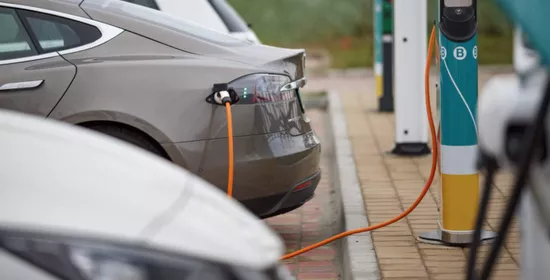
At the beginning, he seemed confident about the sudden "rejection" of the charging station, but when asked whether the plug-in hybrid model he purchased was equipped with the standard DC fast charging function, Mr. Qian hesitated.
After some questioning, he admitted that his plug-in hybrid car was equipped with a slow charging socket as standard As for the so-called DC fast charging function and DC fast charging socket, they are all installed "privately" in the later stage to enable charging at the nearby fast charging station
"Before the fast charging function was added, I always used plug-in mixers as fuel trucks. After all, almost all the slow charging piles around were in the parking lot in the community. Some could not get in, and some had to pay parking fees when charging." He said reluctantly that even if there was a slow charging pile, it would take five hours for the plug-in hybrid vehicle to be fully charged.
However, since I "changed" the DC fast charging, it only takes half an hour to fill the battery of this plug-in hybrid vehicle in the fast charging station, which greatly improves the daily driving experience If the pure electricity mode is used for commuting to and from work, it only needs to be recharged once every two days. "Many owners of plug-in hybrid cars around me have changed the DC fast charging function this year, which is really convenient for driving."
Nowadays, the fast charging station no longer allows the "modified" plug-in hybrid vehicles to enter the site for charging, making Mr. Qian's previous convenient and efficient car use experience instantly come to naught.
In this regard, he and many other car owners feel angry. Similarly, there are many Wuling Hongguang Mini EV owners who are angry about being "discouraged" by the new energy fast charging station.
"Now fast charging doesn't allow me to charge. It takes eight or nine hours to charge the car slowly. It's too much trouble." Xiao Zhong, who lives in Luohu, Shenzhen, revealed that in March this year, he bought a Hongguang Mini with a range of 170 kilometers. When he got it, he installed a fast charging socket on the recommendation of his friends.
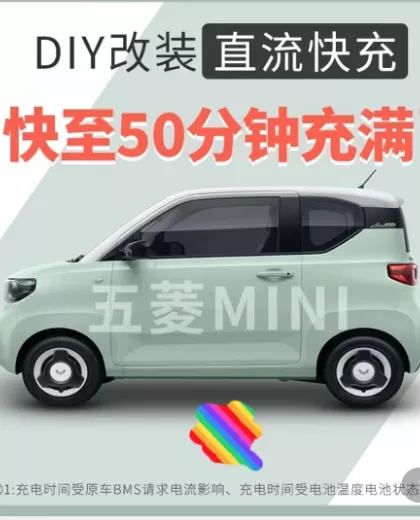
(network screenshot)
The car that used to take eight or nine hours to fill up can be fully filled in only thirty or forty minutes with fast charging. The slow charging "old man le" instantly turned into a walking expert, making him happy. However, since last week, when he went to the nearby fast charging station to charge, he was frequently rejected by the station administrator and even asked to leave the station quickly.
"The security guard told me that the leader had told me that Hongguang Mini EV could not enter the fast charging station, for fear that the modified fast charging port would have problems and damage the fast charging equipment in the station. but a large number of Hongguang Mini EVs that had been changed to fast charging were charging in the charging station, and there was no danger. It was a big fuss!"
Xiao Zhong said excitedly that he, together with many plug-in hybrid and Hongguang Mini EV owners, believed that the "one size fits all" approach of some station managers prohibited the "modification" of plug-in hybrid vehicles and pure electric vehicles with fast charging sockets from entering the site for charging, which was unreasonable. They all said that they would continue to make complaints and continue to strive for their "legitimate" rights and interests.
What makes people wonder is how these owners converted the standard new energy vehicle with slow charging function into a fast charging socket? Compliance?
It only costs three to five thousand yuan to "change magic to electric charging"
Recently, on the mainstream short video platform, new energy owners can often share the "achievements" of hybrid electric vehicles and pure electric vehicles after refitting the quick charging socket through short video. There are some accounts, even in the window for the merchants who provide modification schemes.
Through the account window recommendation, you can easily find several merchants who claim to provide quick charging and refitting solutions It is found that almost all the solutions involve hardware modification and installation on the basis of the high-voltage circuit of the original vehicle
More merchants have marked on the product page that the modification scheme "has sold 50000 units" seems to have a very high sales volume.
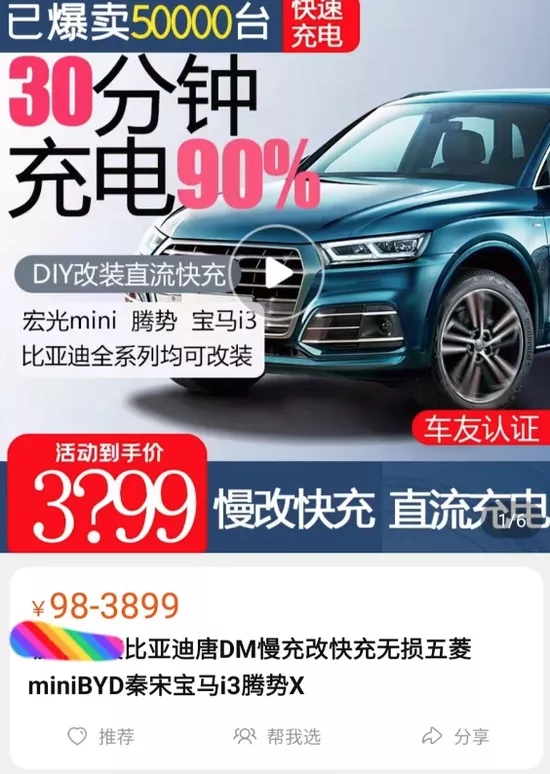
(network screenshot)
"Hybrid and pure electric vehicles with only slow charging sockets can be changed to fast charging, and the charging speed can be increased by more than 90%." When consulting a merchant nicknamed "Caramel" as the owner, the other party boasted that it could sell thousands of fast charging modified equipment every month, and it was absolutely safe and reliable during fast charging.
"Caramel" said that at present, most of the plug-in hybrid vehicles with modification needs for fast charging are plug-in hybrid vehicles with only slow charging port and no DC fast charging function, or pure electric vehicles with only slow charging such as Hongguang Mini ev.
"In order to drive the car as an electric vehicle, plug-in hybrid car owners simply add a fast charging head, which takes a very short time to charge. As for Hongguang Mini EV, many car owners ask us to buy additional hardware as soon as they buy the car, and directly change it to fast charging." So, what is the principle of refitting the slow charging socket of the original vehicle to fast charging?
Some technicians in the industry said that at present, there are not many domestic suppliers providing fast charging and refitting schemes, especially few regular large manufacturers. For the topic of modification, "Caramel" is not shy, "in fact, the modification plug-in hybrid charging port is directly connected with the power battery through a DC charging controller."
As for the electric energy input mode, it is the same as the vehicle kinetic energy recovery principle, using DC - DC step-down recharge, "the slow charging port harness is too small, and the charger has voltage limits, so it is not reliable to directly change to a fast charging port, but the battery kinetic energy recovery system can withstand it, and the charging voltage and current can be higher."
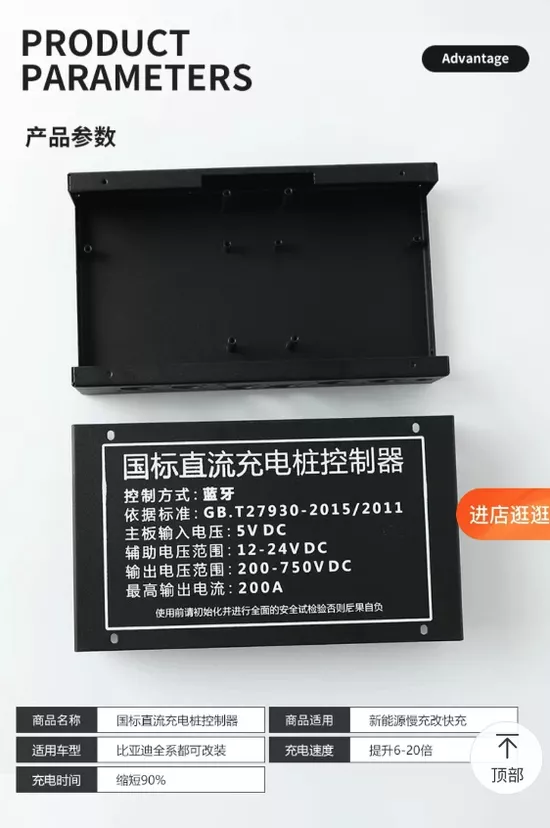
(network screenshot)
"Caramel" frankly said that the charging voltage of hybrid and electric vehicles with only slow charging function is 220V and 380V, but it does not mean that the battery system is also 220V and 380V. The voltage of most power battery systems is between 400 and 750V. Therefore, as long as the charger is bypassed and the fast charging pile is "directly connected" with the vehicle's power battery, fast charging can be realized.
As for the cost of installing quick charging sockets for hybrid and electric vehicles, caramel said that the hardware cost is mostly between 3000 and 5000 yuan. Consumers only need to spend thousands of yuan. Slow charging vehicles become fast charging immediately, and low configuration pure electric vehicles become high configuration immediately.
"If there is no package for installation, we will only send you the fast charging hardware of the corresponding model and detailed modification instructions. If you go to an auto repair shop, you can basically follow the tutorial to install the hardware. The fast charging ports are installed in the front bonnet." Caramel assures that the hardware it represents has industry standards.
On the fast charging controller provided by several merchants, you can see the printed gb T27930-2015. After query, it is found that gb The recommended standard corresponding to t27930-2015 is the communication protocol between off board conductive charger and battery management system of electric vehicles.
Some people in the industry pointed out that gb T27930-2015 recommended standard is usually found in portable charging piles, some DC charging piles, etc., and non vehicle mounted conductive chargers. As for the charging equipment "modified" and installed in the vehicle, it is not applicable to this. The manufacturer's labeling of the products with the so-called national standards is just a bluff.
Obviously, it is only "wishful thinking" for the owner to spend a few thousand yuan to upgrade the vehicle that can only use slow charging to fast charging, and make a great leap in the car experience.
It is not difficult to imagine that under this kind of "gimmick", a large number of new energy owners will be attracted and choose to modify the fast charging function of the car.
Is there any hidden risk behind the modified quick charging socket?
Who is taking advantage of the quality assurance service
When asked whether the installation of the quick charging socket would cause damage to the vehicle's electronic control system and power battery, all businesses answered confidently: No. They claim that the fast charging hardware solutions produced by the manufacturer are relatively mature, safe, stable and reliable.
Some merchants told that even if the electric control and battery were damaged due to fast charging, the car owner should not worry. At present, most new energy vehicles are known as "three electricity" system lifetime warranty. "In case of any failure, the warranty service of the main engine factory is also available, so you can buy it with confidence."
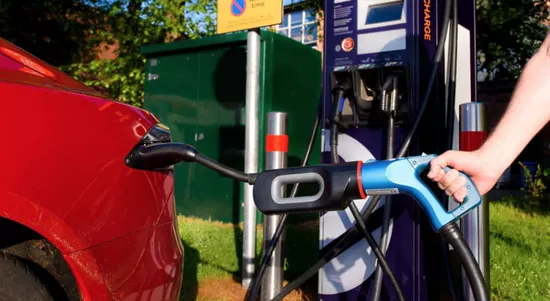
Is that really the case?
"It's really boasting without making a draft. Car companies are not fools. It's easy to see if they have been artificially modified."
As the after-sales supervisor of an independent automobile brand, Liu Sen (not his real name) definitely told me that adding a fast charging socket to a vehicle that originally did not have a fast charging function was an illegal modification. Moreover, if the "three electricity" system is damaged due to the owner's modification of the vehicle design, the vehicle enterprise will not guarantee the quality once it is verified**
At the same time, he also stressed that the insurance company will not pay for the safety accidents caused by the owners' unauthorized modification of the quick charging port.
"In recent months, it has been found that many plug-in hybrid vehicles maintained at the terminal have added quick charging ports in the front engine compartment. After sales and maintenance personnel usually advise the owner to remove them so as not to affect the vehicle safety and quality assurance." He said that using the "three noes" hardware to transform the "three electricity" system would bring endless trouble.
"Recently, the company informed that all the fast charging stations would not allow the modified hybrid cars and micro electric vehicles to enter the site." Chenhao, the duty stationmaster of a new energy fast charging station in Huizhou, also said that although he has not heard of any fire cases of electric vehicles and plug-in hybrid vehicles that have been changed to fast charging, such changes are indeed a potential safety hazard and may even endanger other vehicles in the fast charging station.
In his opinion, since some plug-in hybrid cars and small electric vehicles originally did not reserve fast charging transformation and installation positions, many of the installed fast charging sockets are in the front cabin, and the owners need to open the front cabin cover every time they charge. "It's too unsafe to charge in rainy days."
At the same time, since it is difficult to define the insurance compensation liability of vehicles after the transformation of fast charging, once a safety accident or even spontaneous combustion occurs, the charging station will inevitably have joint and several liability, resulting in huge losses. "Moreover, even if the fast charging port is modified, the charging efficiency of plug-in hybrid vehicles and small electric vehicles is also very low."
Chen Hao stressed that the maximum charging power of almost all fast charging vehicles reconstructed by using the kinetic energy recovery function (DC - DC voltage reduction device) is only 30kW, which is half of the normal power demand of the fast charging pile, and may even be one fourth. Therefore, it will affect the operating efficiency of the fast charging station.
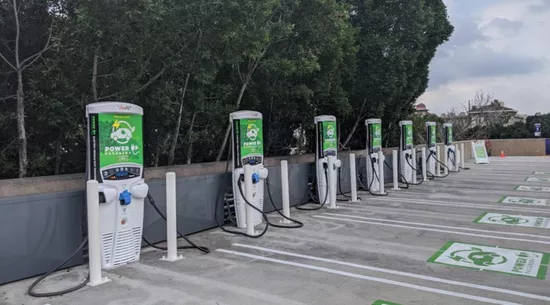
"They all park for free for two hours, and they are fully charged in about half an hour. People's normal pure electric vehicles are charged with dozens of degrees of electricity, while the modified plug-in hybrid and small and micro electric vehicles are only charged with a few degrees of electricity. The charging station must be dead."
Chen Hao said reluctantly that during the May Day holiday this year, he saw many "transformed" Hongguang Mini EVs who, in the name of charging, came to the station for two hours of free parking, which affected the normal charging of many car owners**
It can be seen that there are great risks hidden behind the refitting of fast charging socket with great market demand. Although the car owner can greatly improve the experience of using the car at a cost of only RMB 35000, and even "transform" the low configuration into high configuration, he may also lose the right to guarantee the quality, insurance compensation and normal charging.
This business may be the most unreliable "business opportunity" in the new energy era.